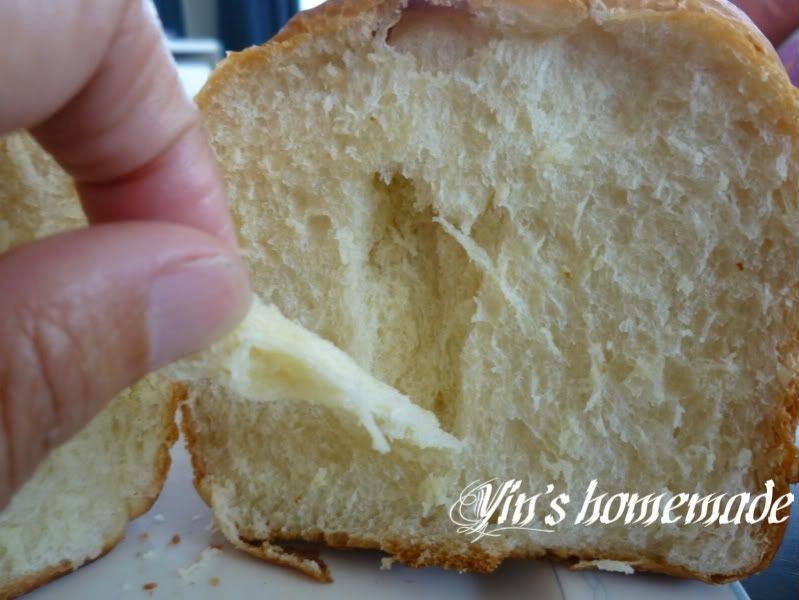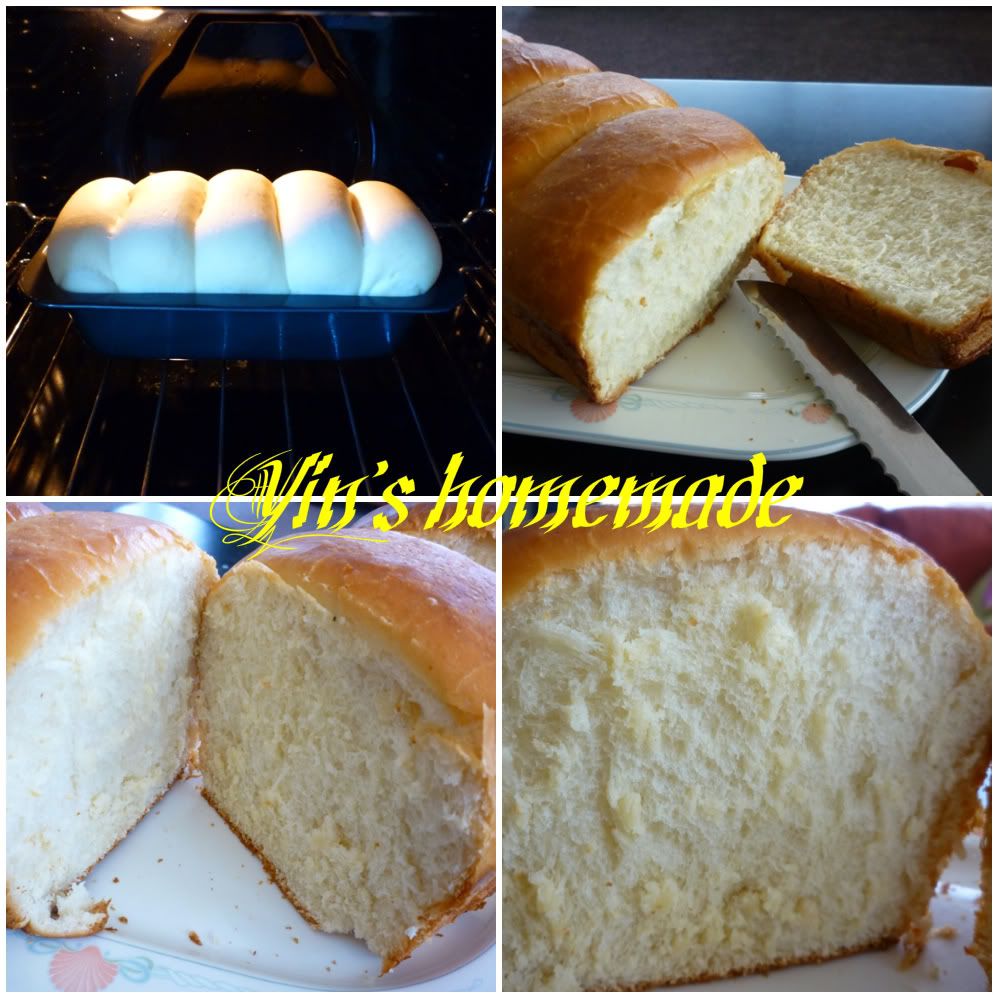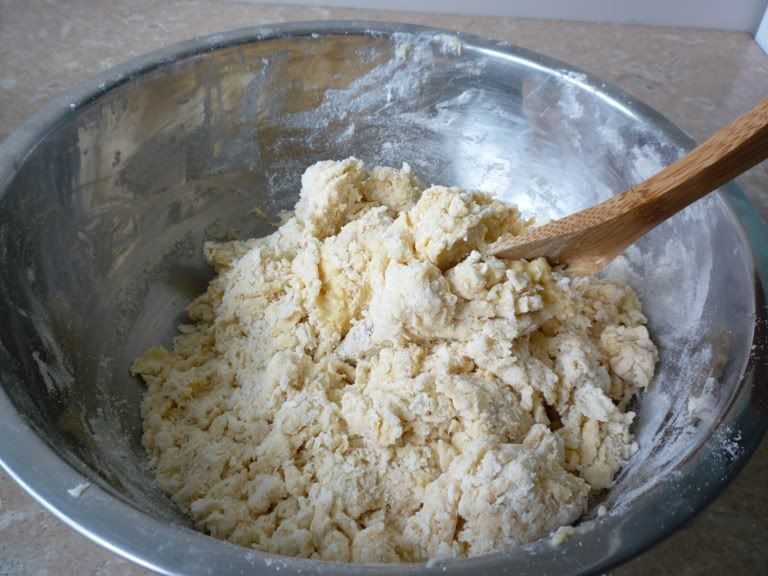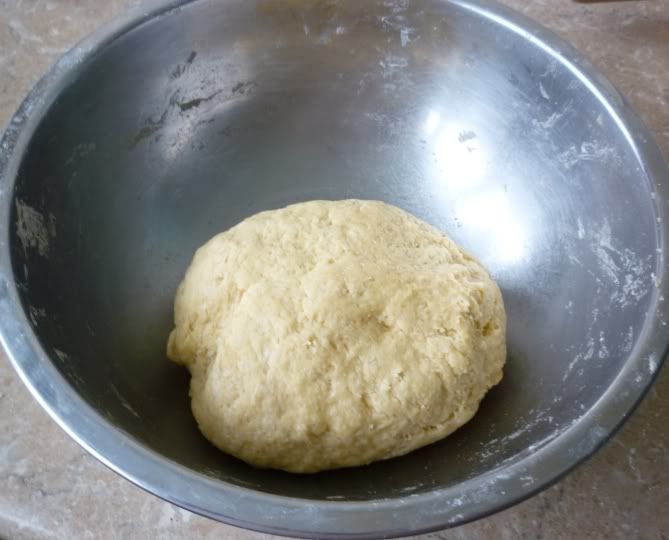Tang Zhong (Water Roux) Bread Making Part 2 – The success
As our old Chinese proverb quotes "failure is the mother of success". I was not held back by the last 3 tumbles I experienced with Tangzhong bread making. I moved on to try out Yvonne Chen's Tangzhong White Toast bread recipe and this time I finally got it right! I felt so contented the moment I sliced open the center of the loaf and revealed cottony, fluffy and spongy texture J
 |
| Fluffy and spongy Cottony Toast Bread 波特吐司 (湯種法) |
 |
| Cottony Toast Bread (Featured in Group Recipes 17/11/2010) |
Compare to the direct bread making method, the dough using water roux method is much stickier. No wonder many suggested using dough mixer to do the mixing and kneading for Tanzhong bread. But, if you like the idea of 100% handmade then you must prepare to stick your hands into gloppy and gooey mess dough. I tried to use wooden spatula to mix the dough as much as possible until the dough was too sticky to move then only I used hands. In my opinion, the final kneading was the most tiring part; I spent 15 minutes to totally blend in the butter to form glossy, smooth and stretchy dough. Overall, it took me about 40 to 45 minutes of hand mixing and kneading time before the dough was ready for it first proof.
This recipe I shared was based on my hand kneading experience; for original recipe using machine kneads you can refer to Christine Recipes of her Tanzhong Hokkaido Milky loaf.
繼續閱讀中英对照食谱
COTTONY TOAST BREAD (WATER ROUX STARTER) INGREDIENTS: Bread Dough : A: 365g high grade flour (Bread Flour ) 12g Milk powder 7g Salt 30g caster Sugar 8g Instant Dry Yeast B: 150ml Milk 120g Tangzhong ( 50g High grade flour : 250ml Water ) C: 30g melted Butter TANGZHONG (WATER ROUX STARTER) MAKING METHOD:: Basic Formula: The ratio of flour to water is 1:5 This means mix up 1 part of High grade flour (Bread flour) with 5 parts of water (by weight) at 65°C to form runny dough with traces. By traces means you can forms impressions by stirring the paste. DIRECTION:
Notes: This Tangzhong starter can be kept for 1-2 days in refrigerator. However, discard once the mixture turns grayish. DOUGH MAKING METHOD: (HAND KNEADING METHOD)
Notes: For this recipe, I had revised down to 77% from original measurements. This was because I was running out of high grade flour and the amount of flour I had on hand was only 77% of the original recipe. 波特吐司 (湯種法) 汤种材料: 高粉50克,水250克 高粉和水混合搅匀,开小火慢煮,要不停的搅拌以防粘底,搅拌到面糊有纹路或温度65度时离火,盛出让它在室温冷却(几个小时)后再使用。汤种面糊用不完,可冷藏保存1-2天时间。收至面糊变灰色就不可用。 吐司材料: A: 高粉365克,白砂糖30克,盐7克,干酵母8克,奶粉12克, B: 牛奶150克,汤种120克, C:牛油30克 做法 將材料放入攪拌盆, 加入材料 A, 把酵母和糖、鹽分開放。以免脫水。 再加入材料B后用抹刀将面粉攪拌成团,直到面团太粘,才开始用双手揉面团。 最初5分钟,你将体验非常黏手的面团,只要继续揉,面团将逐步成形。 一旦面团成形,你可以开始把面团倒在干净光滑的台面继续揉。不需要在台面上撒粉。 我花了至少10-15分钟才把面团搓成有弹性和筋膜的面团。 然后把面团放置回盆里,加入融化的牛油。这时你将面对很油腻很不像样的面团。 但坚持搓下去,10分钟后,一旦面团没那么油腻,回迁台面揉面至光滑,富有弹性可扩展阶段的面团。把揉好的面团放入干净的容器中,跟着用保鲜膜盖好,作第一次发酵,至面团发大两倍。(手指测试 - 将手指戳下面团中心起不来,就证明面团充分发酵) 用手关节拍下排去面团内部的空气,分割成5份滚圆,松弛15分钟。 将5份面团擀成椭圆形;自上而下卷成圆筒状,收口朝下,依次放入排入抹油的面包盘或吐司盒用保鲜膜覆盖继续进行最后发酵。把烤箱预热180度。我没在面团上塗蛋液我只用少量的水喷在面包团才放入烤箱中烘烤30分钟。为了避免面包过于上色,烘烤15-20分钟后我就用铝箔轻轻盖上面包,继续烘烤,直到所需的时间。出炉后立即脱模。 |






Grazie per la ricetta. Saluti Giulia (Italy)
ReplyDeleteHi Yin,
ReplyDeleteSo glad to had found your blog and I've tried out your recipe above and love the cottonny soft texture of the bread (I made sausage buns). Thanks and I would like to seek for your consent to share this with my friends who is seeking for soft buns recipe. Fyi my last name is also "yin". Thanks a lot for sharing.
Hi Yin:
ReplyDeleteCongrats on your success, very please to hear that. It's my pleasure to share. Glad that you find this recipe is useful and welcome to share with your friends, I hope they like it too.
Hi Yin,
ReplyDeleteThank you for the lovely recipe. Can I use the tangzhong on other bread recipes? I would like to try oatmeal bread recipe, not sure if you'd tried making it before. Thanks.
Hi there:
ReplyDeleteThanks for dropping by and hope you find more recipes that you like and continue to support me.
Yes, you can use tangzhong method on any bread recipes. Just keep in mind the ratio is 1 part of bread flour :5 parts of water.
I did have another instant soya oatmeal bread that you can check out. Click on the Recipe Index page and go to bread and you can check out various tanzhong breads that I had shared.
YP, what is the purpose of adding this tangzhong? Can we just omit this ingredient and use the recipe anyway?
ReplyDeleteYP, what is the purpose of adding this tangzhong? Can we just omit this ingredient and use the recipe anyway?
ReplyDeleteBC:
DeleteThe Tangzhou 汤种 is the main starter for the bread, key factor to get fluffy and soft bread. If you omit this starter then you are reverting to traditional bread making where the bread won't have the same fluffly texture and easily get harden by the next day. (if you didn't add in bread improver)
But I would strongly encourage you to give it a try, after that you won't want to go back to traditional bread making. :-)
Hallo! I am very interested in trying the TZ method and got started today. I am new to baking and as well as making bread. I measured all the ingredients according to the recipe but after kneading for 30 minutes after adding the butter, the dough is still sticky. Is it normal? I am not really that sure what I should do with it. Hope to hear your advise soon! =)
ReplyDeleteDear Manglishly Mush:
DeleteNice to have you here. Thanks for trying out the recipe.
For your question, yes it is quite normal to have TZ dough wetter than the traditional method.
Are you hand knead your dough? For my experience with hand knead TZ dough, I usually need more than 30 minutes about 45 minutes to have a good consistency of elastic dough.
Yes, you will expect very gooey dough after you add in butter. Hence, sometime after I added TZ starter and if the dough gets wetter, then I will reduce the melted butter input.
Best also to make your TZ a night before to avoid having wet TZ starter.
Hope this little tips help you to improve your trying. Do update me on your result :-)
oh yes, you can also reduce a bit of milk if you find your TZ starter is runny. Try on 130ML for a change.
DeleteHi Yin, Would all-purpose flour also work for this recipe?
ReplyDeleteHi there:
DeleteWell, not encourage to do so. My neighbour did that and she said her bread wasnt rise enough and hard to eat.
The plain/multipurpose flour not enough gluten to get that elastic texture for soft fluffy effect.
Hi Yin, can i use tangzong recipe in my bread maker for dough?
ReplyDeleteTo use tangzhong in bread making, what is the ratio for TZ to flour?
DeleteMy toast bread recipe 280g flour, 175ml milk. How much TZ i need to add in? Do I need to reduce my milk/water if TZ is used?
Thanks.
Yes, you can try to use the above recipe ratio of flour, milk and tangzhou to work on your recipe.
DeleteSometime I work on recipe formula exactly like doing math, just applied the same straight line method hahaha......
Haha, am studying my maths formula when i measure all the ingredients too.
DeleteAm trying out the TZ method in sausage rolls, they are softer than all my earlier sausages rolls. Let's see few hrs later, will they still be soft n fluffy.
By the way, am oso trying out Taiwanese Carol Hu's (dough overnite in fridge) method. 低温发酵, just want to see which method is more appropriate to me.
This recipe, if without milk powder, ok?
DeletePenny:
DeleteYes, you can. The milk powder just to add milk flavour to it. :-)
Hi Yin,
DeleteJust baked cottony toast bread.
Follow exactly ur recipe, texture is soft...love it.
Hubby is bread lover, will try ur the other recipe soon.
Thanks for ur sharing.
Penny:
DeleteSo glad to hear from you on your successful batch of soft bread! Yeah!
Hi Yin, I have total baked 3 cottony toast bread.
ReplyDelete2 were using bread maker whole process, texture was great!
1 was knead in bread maker, then I baked in oven follow ur recipe steps.
Bread texture was neither soft nor fluffy, is dense.
Why?
Penny:
DeleteGlad you had another success!
Bread becomes dense, quite a number of reasons:
1) kneading - dough well knead? stretch test to pull into thin layer?
2) proofing - dough well proof? finger impression test, image remain?
Anyway, if you find using breadmaker is simple and get the right texture then stick with it, as it is all automated and less hassle for you.